(Really) Small Houses Under the Big Sky
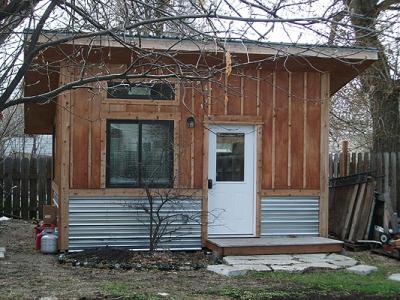
(Really) Small Houses Under the Big Sky
by Joseph Shelton
I am standing in Paul House’s yard (behind the historic Bozeman Cottage) on a sunny day on the cusp of summer. A rain overnight has softened the ground, and a pair of robins pluck worms to an accompaniment of a hen’s envious clucks on the other side of a fence.
“And there you can see the spot where my old Air Stream was for nine years until yesterday,” laughs Paul, a picture of good old-fashioned health, much the same as his yard.
He is showing me the Nano house that he has built. A small self-sufficient structure that aims for energy efficiency, it is part of the housing revolution at work. Paul’s is small and stylish (“I wanted it to look nice, but not as if it was assembled by Ikea,” Paul says), with windows designed for optimum sun and a roof that slopes gently forward. At 161 sq. ft. it is cozy, and it currently serves as Paul’s office.
There was a time not so long ago, on a Montana timescale, that energy-efficient housing wasn’t just a wise choice, it was a necessary part of an often rough life. Small family dwellings were made of sod and dirt. Native Americans, evidently blessed with an intuitive grasp of simple, sustainable building principles, made small and centrally heated homes out of animal skins and sticks. In the last century or more the importance of ingenuity and conservation in the construction of our homes has taken on a new urgency. The rising price of energy and the increasing scarcity (and again, cost) of materials are once again making us reconsider how we live. Waste in the past and now our time is an unaffordable luxury.
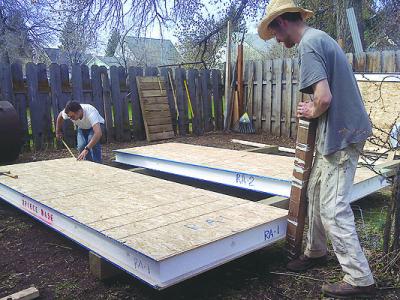
Nano houses (that’s “nano” for small, of course) originated as an idea in Sweden. They are very small, usually made out of new or alternative building materials and feature small but intelligently utilized spaces. The world is fast getting hip to the versatility of small, green, and free-standing structures such as these, and Montana’s not far behind.
Even in vast Big Sky country, structures like the Nano house offer myriad benefits. As Paul points out, “The free-standing aspect of the studio or house or office adds privacy and is simpler than attaching an addition to an existing home.” And since he only uses a wood stove and about 20 amps of electricity, it’s beyond green. As I inspect the rustic landscaping he’s put around the spot, it seems even the decorations are green, made from the bottom halves of reclaimed and literally green-tinted glass bottles.
For Paul, and the many pioneers of sustainable housing in Montana, the available building materials now include things that would have boggled the imaginations of early Montanans. Such as SIPS or structural insulating panels, out of which most Nano houses are built, it is a composite building material, made of a hard foam core between layers of structural board. They are a little more expensive, Paul says, but they will also save money on labor, and many alternative housing projects are made at least partially out of SIPS. But using man-made materials is only one aspect of the housing revolution. The other is very nearly the opposite, reclaiming existing materials to create new and beautiful pieces. Paul himself has used reclaimed flooring in his Nano House.
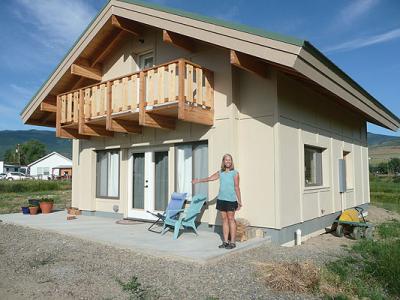
Another pioneer in the field is Terry Davenport (of Natural Housebuilders, in Victor, MT), who is passionate about reclaimed materials, not to mention creative as well. He has recently converted an antique church organ into doors and cabinets for one house.
“I have a need to improve stuff that I like to build. This comes from my younger days of motocross racing and we were always trying to improve our motorcycles,” Davenport remembers. “There was a suspension revolution going on, and I got involved. Then I shifted that interest into building homes.”
He prefers to use organic materials such as reclaimed lumber and cement but he sees the value in synthetics as well, but even there his yen for sustainability is such that he eschews foam insulated concrete forms, using instead ones made from recycled pallets and concrete paste. In one recent addition he added some 1200 sq. ft. to the home, and still managed to reduce their utilities in half. The homeowners were understandably pleased with the results: “They love their house,” Davenport smiled, “and they were great to work for. They are still glad to see me when we cross paths.”
Mark Weirich of Architect Inc. in Bozeman is another pioneer with principles, and something he wrote me in an email sums up the ethos of alternative housing. ‘If I can design a space that fits a client’s needs but which is only half the size they believe they need, then only half of the materials are used, and only half as much needs to be heated”.
This is very true of Paul’s Nano house, in which a single wood stove bought off of Amazon makes up for what the sun doesn’t, which isn’t much.
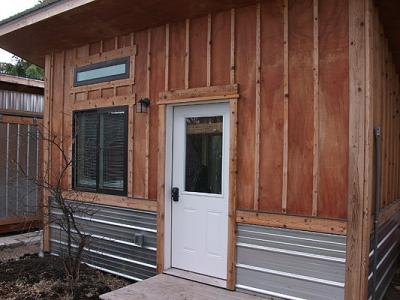
If the prospect of downsizing does not appeal to you, or is not possible, there is always the possibility of simply changing your existing space. Besides installing a solar array or other energy-efficient system, you can make your spot greener using the same principles that House, Davenport and Weirich mentioned.
In some of his work, Weirich says that in several houses he has taken “everything back to the studs, joists and rafters, then added some high-efficiency space, too. Doing this type of work I consider to be very green, for a few reasons: The walls and roofs are brought up to current standards of insulation, where the old construction had little or no insulation. Almost always, the window sizes are increased, adding to the passive solar abilities of the home. The heating systems are also brought up to current standards, which are much more efficient than the old systems.”
The work of these three builders, and many more, look forward to a world in which more sustainable building principles are the norm. But they also look back to those pioneers and Native Americans, who managed to create homes that could house them comfortably but which did not leave behind a footprint.
And so, as I stand in this beautiful yard under a beautiful, Big Sky in the morning, I reflect that it is fitting that Paul’s Nano house rests on the same land as an historic property. Montana has always been a place where the old and new mingle, which is perhaps the trend for the future of our state’s housing, and the world’s.
If the work of these modern energy-efficiency experts has piqued
your interest, we encourage you to investigate further.
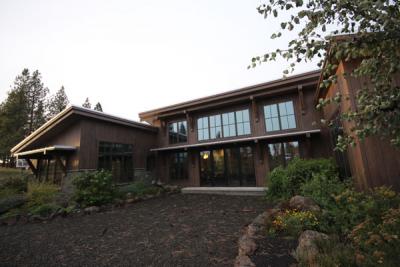
Paul House and his company, Choice Energy, do more than construct Nano houses. They also make solar energy systems for homes, hangars, garages, and other spaces in the Gallatin Valley. See the Choice Energy Web site at
www.choiceenergy.org.
Terry Davenport’s Natural Housebuilders constructs high-performance green homes in the Bitterroot Valley and the Missoula area. His Web site is
www.naturalhousebuilder.net.
Mark Weirich Architect, Inc. operates in the Bozeman area and does remodels and additions, commercial areas, and interiors with an eye toward intelligent, green design. Go to www.markweiricharchitect.com.
Get in Touch With Your Inner Bilbo
The Hobbit House of Trout Creek, Montana, is an architectural imagining come to life. Stay in a fanciful suite embraced within MIddle-Earth and designed with incredible attention to detail. The Shire of Montana is meticulously conceived and masterfully built. Unique...a mystical experience.
www.hobbithouseofmontana.com
by Joeseph Shelton
Leave a Comment Here